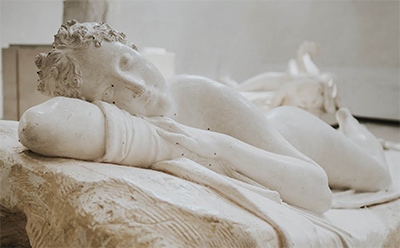The Sleeping Nymph sculpture shows a woman sleeping. She lies on her stomach, facing left while her head rested on her right hand. It is the last work Canova took up.
He started the statue in 1821 but died before its completion. His students finished it in 1822 and dedicated it to their teacher. Historically, nymphs are semi divinities and are associated with Zeus through his daughters. They represent nature and its properties which is evident in the freshness of this sculpture. The white marble illuminates the statue, while the pose is the key attraction. Medieval art mirrored events and social constructs, and drawing or carving people is one of them.
He combined classical art and baroque style with historical connotations. Among the last pieces of art Canova did include Paris (1816), The Three Graces (1817) and Hebe (1817), Venus and Mars (1815 – 1819) and Venus Italica (1819). History remembers Antonio Canova as the best neoclassical artist of his generation. His marble sculptures received recognition in Italy, France and the United Kingdom.
Canova was born into an artistic family. His father was a stone cutter while his grandfather was a stonemason. When he became of age, his grandfather took him to his quarry where he made stone alters. Canova developed an interest in carving. He went for his apprenticeship at Giuseppe Bernardi workshop for two years before doing his pupillage with Giovanni Ferrari. Afterwards, he enrolled at the prestigious Accademia di Belle Arti di Venezia. Here he won numerous accolades for his unique statues.
He did some work for Senator Giovanni Falier, Girolamo Zulian and the Venice monastery. At this young age, Canova's work resembled Filippo Farsetti, a reputable sculptor in Italy at that time. He travelled far and wide, visiting the city of Rome and studying the Michelangelo sketches. His fame eased his way into France and England. He received patronage offers in Eastern Europe where his art’s popularity grew. He also did a statue of George Washington, currently housed at the North Carolina Museum. Tempio Canoviano has some of his life works. Upon returning to Italy, he became the president of the Accademia di San Luca, an Artist Association in Rome. Using this position, he mentored other budding artists such as Richard Westmacott, a Briton, and John Gibson, a renowned Welsh sculptor.




